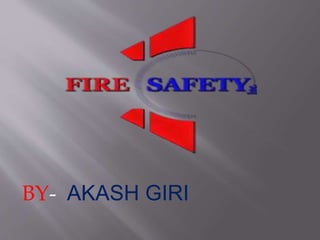
fire safety
- 2. The triangle illustrates the three elements a fire needs to ignite: heat, fuel, and an oxidizing agent (usually oxygen). A fire naturally occurs when the elements are present and combined in the right mixture,[2] meaning that fire is actually an event rather than a thing. A fire can be prevented or extinguished by removing any one of the elements in the fire triangle. For example, covering a fire with a fire blanket removes the oxygen part of the triangle and can extinguish a fire. In large fires where firefighters are called in, decreasing the amount of oxygen is not usually an option because there is no effective way to make that happen in an extended area. Fire triangle
- 3. The fire tetrahedron represents the addition of a component in the chemical chain reaction, to the three already present in the fire triangle. Once a fire has started, the resulting exothermic chain reaction sustains the fire and allows it to continue until or unless at least one of the elements of the fire is blocked. Foam can be used to deny the fire the oxygen it needs. Water can be used to lower the temperature of the fuel below the ignition point or to remove or disperse the fuel. Halon can be used to remove free radicals and create a barrier of inert gas in a direct attack on the chemical reaction responsible for the fire. Combustion is the chemical reaction that feeds a fire more heat and allows it to continue. When the fire involves burning metals like lithium, magnesium, titanium, etc. (known as a class-D fire), it becomes even more important to consider the energy release. The metals react faster with water than with oxygen and thereby more energy is released. Putting water on such a fire results in the fire getting hotter or even exploding. Carbon dioxide extinguishers are ineffective against certain metals such as titanium. Therefore, inert agents (e.g. dry sand) must be used to break the chain reaction of metallic combustion. In the same way, as soon as one of the four elements of the tetrahedron is removed, combustion stops. Fire tetrahedron
- 4. The oxidizer is the other reactant of the chemical reaction. In most cases, it is the ambient air, and in particular one of its components, oxygen (O2). By depriving a fire of air, it can be extinguished; for example, when covering the flame of a small candle with an empty glass, fire stops; to the contrary, if air is blown over a wood fire with bellows, the fire is activated by the introduction of more air. In certain torches, gaseous oxygen is introduced to improve combustion. Some chemicals, such as fluorine gas, perchlorate salts such as ammonium perchlorate, or chlorine trifluoride, act as oxidisers, sometimes more powerful ones than oxygen itself. A fire based on a reaction with these oxidisers can be very difficult to put out until the oxidiser is exhausted; that leg of the fire triangle cannot be broken by normal means (i.e., depriving it of air will not smother it). In certain cases such as some explosives, the oxidizer and combustible are the same (e.g., nitroglycerin, an unstable molecule that has oxidizing parts in the same molecule as the oxidizeable parts). Reaction is initiated by an activating energy, in most cases, it is heat. Several examples include friction, as in case of matches, heating an electrical wire, a flame (propagation of fire), or a spark (from a lighter or from any starting electrical device). There are also many other ways to bring sufficient activation energy including electricity, radiation, and pressure, all of which will lead to a temperature rise. In most cases, heat production enables self-sustainability of the reaction, and enables a chain reaction to grow. The temperature at which a liquid produces sufficient vapor to get a flammable mix with self-sustainable combustion is called its flash-point. Oxidizer
- 5. Fire safety is the set of practices intended to reduce the destruction caused by fire. Fire safety measures include those that are intended to prevent ignition of an uncontrolled fire, and those that are used to limit the development and effects of a fire after it starts. INTRODUCTION
- 6. 1. CLASS A 2. CLASS B 3. CLASS C 4. CLASS D 5. CLASS K
- 7. CLASS A: Class A fires involve common combustibles such as wood, paper, cloth, rubber, trash and plastics. They are common in typical commercial and home settings, but can occur anywhere these types of materials are found.
- 8. CLASS B: Class B fires involve flammable liquids' gases, solvents, oil, gasoline, paint, lacquers, tars and other synthetic or oil-based products. Class B fires often spread rapidly and, unless properly secured, can reflash after the flames are extinguished.
- 9. CLASS C: Class C fires involve energized electrical equipment, such as wiring, controls, motors, data processing panels or appliances. They can be caused by a spark, power surge or short circuit and typically occur in locations that are difficult to reach and see.
- 10. CLASS D: Class D fires involve combustible metals such as magnesium and sodium. Combustible metal fires are unique industrial hazards which require special dry powder agents.
- 11. CLASS K: Class K fires involve combustible cooking media such as oils and grease commonly found in commercial kitchens. The new cooking media formulations used form commercial food preparation require a special wet chemical extinguishing agent that is specially suited for extinguishing and suppressing these extremely hot fires that have the ability to reflash.
- 12. FIRE SAFETY EQUIPMENTS 1. FIRE ALARAM 2. SMOKE DETECTER 3. WATER MONITOR 4. HYDRANT ACCESSORIES 5. FIRE MAN AXE 6. SAFETY HELMET 7. SYNOGES 8. HOSE REEL